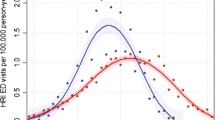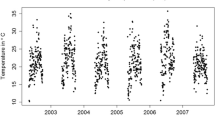Abstract
Periods of successive extreme heat and cold temperature have major effects on human health and increase rates of health service utilisation. The severity of these events varies between geographic locations and populations. This study aimed to estimate the effects of heat waves and cold waves on health service utilisation across urban, regional and remote areas in New South Wales (NSW), Australia, during the 10-year study period 2005–2015. We divided the state into three regions and used 24 over-dispersed or zero-inflated Poisson time-series regression models to estimate the effect of heat waves and cold waves, of three levels of severity, on the rates of ambulance call-outs, emergency department (ED) presentations and mortality. We defined heat waves and cold waves using excess heat factor (EHF) and excess cold factor (ECF) metrics, respectively. Heat waves generally resulted in increased rates of ambulance call-outs, ED presentations and mortality across the three regions and the entire state. For all of NSW, very intense heat waves resulted in an increase of 10.8% (95% confidence interval (CI) 4.5, 17.4%) in mortality, 3.4% (95% CI 0.8, 7.8%) in ED presentations and 10.9% (95% CI 7.7, 14.2%) in ambulance call-outs. Cold waves were shown to have significant effects on ED presentations (9.3% increase for intense events, 95% CI 8.0–10.6%) and mortality (8.8% increase for intense events, 95% CI 2.1–15.9%) in outer regional and remote areas. There was little evidence for an effect from cold waves on health service utilisation in major cities and inner regional areas. Heat waves have a large impact on health service utilisation in NSW in both urban and rural settings. Cold waves also have significant effects in outer regional and remote areas. EHF is a good predictor of health service utilisation for heat waves, although service needs may differ between urban and rural areas.




Similar content being viewed by others
References
ABS. (2011). Australian Standard Geographical Classification (ASGC). Retrieved from http://www.abs.gov.au/AUSSTATS/abs@.nsf/Lookup/1216.0Main+Features1July%202011?OpenDocument
ABS. (2013). Census of Population and Housing: Socio-Economic Indexes for Areas (SEIFA). Retrieved from http://www.abs.gov.au/ausstats/abs@.nsf/Lookup/2033.0.55.001main+features42011
Alston M (2002) Social capital in rural Australia. Rural Soc 12(2):93–104. doi:10.5172/rsj.12.2.93
Anderson GB, Bell ML (2011) Heat waves in the United States: mortality risk during heat waves and effect modification by heat wave characteristics in 43 U.S. communities. Environ Health Perspect 119(2):210–218. doi:10.1289/ehp.1002313
Armstrong B (2006) Models for the relationship between ambient temperature and daily mortality. Epidemiology 17(6):624–631. doi:10.1097/01.ede.0000239732.50999.8f
Australian Bureau of Meteorology (ABM) (2012). Climate classification maps. Retrieved from http://www.bom.gov.au/jsp/ncc/climate_averages/climate-classifications/index.jsp?maptype=tmp_zones
Barnett AG, Hajat S, Gasparrini A, Rocklov J (2012) Cold and heat waves in the United States. Environ Res 112:218–224. doi:10.1016/j.envres.2011.12.010
Bhaskaran K, Gasparrini A, Hajat S, Smeeth L, Armstrong B (2013) Time series regression studies in environmental epidemiology. Int J Epidemiol 42(4):1187–1195. doi:10.1093/ije/dyt092
Callen JL, Blundell L, Prgomet M (2008) Emergency department use in a rural Australian setting: are the factors prompting attendance appropriate? Australian Health Review November 32(4):710–719
Cheng X, Su H (2010) Effects of climatic temperature stress on cardiovascular diseases. Eur J Intern Med 21(3):164–167. doi:10.1016/j.ejim.2010.03.001
Davies, A., Tonts, M., Tro, L., & Pelusey, H. (2009). Australia’s rural workforce. Retrieved from Canberra, ACT, Australia
De Donato FK, Leone M, Noce D, Davoli M, Michelozzi P (2013) The impact of the February 2012 cold spell on health in Italy using surveillance data. PLoS One 8(4):e61720. doi:10.1371/journal.pone.0061720
Diaz J, Carmona R, Miron IJ, Ortiz C, Leon I, Linares C (2015) Geographical variation in relative risks associated with heat: update of Spain’s heat wave prevention plan. Environ Int 85:273–283. doi:10.1016/j.envint.2015.09.022
Fleming DM, Elliot AJ (2005) The impact of influenza on the health and health care utilisation of elderly people. Vaccine 23(Suppl 1):S1–S9. doi:10.1016/j.vaccine.2005.04.018
Gasparrini A, Armstrong B (2011) The impact of heat waves on mortality. Epidemiology (Cambridge, Mass.) 22(1):68–73. doi:10.1097/EDE.0b013e3181fdcd99
Greenland S (1995) Avoiding power loss associated with categorization and ordinal scores in dose-response and trend analysis. Epidemiology 6(4):450–454
Guo Y, Gasparrini A, Armstrong B, Li S, Tawatsupa B, Tobias A et al (2014) Global variation in the effects of ambient temperature on mortality: a systematic evaluation. Epidemiology (Cambridge, Mass) 25(6):781–789. doi:10.1097/EDE.0000000000000165
Huynen MMTE, Martens P, Schram D, Weijenberg MP, Kunst AE (2001) The impact of heat waves and cold spells on mortality rates in the Dutch population. Environ Health Perspect 109(5):463. doi:10.1289/ehp.01109463
Jones DA, Wang W, Fawcett R (2009) High-quality spatial climate data-sets for Australia. Australian Meteorological and Oceanographic Journal 58(4):233
Keatinge WR, Donaldson GC (2004) The impact of global warming on health and mortality. South Med J 97(11):1093–1099. doi:10.1097/01.SMJ.0000144635.07975.66
Loughnan ME, Tapper NJ, Phan T, McInnes JA (2014) Can a spatial index of heat-related vulnerability predict emergency service demand in Australian capital cities? International Journal of Emergency Services 3(1):6–33. doi:10.1108/ijes-10-2012-0044
Nairn JR, Fawcett R (2013) Defining heatwaves: heatwave defined as a heat-impact event servicing all community and business sectors in Australia/John Nairn and Robert Fawcett. Centre for Australian Weather and Climate Research, Kent Town, South Australia
Nairn JR, Fawcett RJ (2015) The excess heat factor: a metric for heatwave intensity and its use in classifying heatwave severity. Int J Environ Res Public Health 12(1):227–253. doi:10.3390/ijerph120100227
Nitschke M, Tucker G, Bi P (2007) Morbidity and mortality during heatwaves in metropolitan Adelaide. Med J Aust 187(11–12):662–665
O’Neill MS, Ebi KL (2009) Temperature extremes and health: impacts of climate variability and change in the United States. J Occup Environ Med 51(1):13–25. doi:10.1097/JOM.0b013e318173e122
R Core Team (2016) R: A language and environment for statistical computing. R Foundation for Statistical Computing, Vienna, Austria. https://www.R-project.org/
Scalley, B. D., Spicer, T., Jian, L., Xiao, J., Nairn, J., Robertson, A., & Weeramanthri, T. (2015). Responding to heatwave intensity: Excess Heat Factor is a superior predictor of health service utilisation and a trigger for heatwave plans. Aust N Z J Public Health. doi:10.1111/1753-6405.12421
Schaffer A, Muscatello D, Broome R, Corbett S, Smith W (2012) Emergency department visits, ambulance calls, and mortality associated with an exceptional heat wave in Sydney, Australia, 2011: a time-series analysis. Environ Health 11(1):3. doi:10.1186/1476-069X-11-3
Sheridan SC, Allen MJ (2015) Changes in the frequency and intensity of extreme temperature events and human health concerns. Current Climate Change Reports 1(3):155–162. doi:10.1007/s40641-015-0017-3
Sun X, Sun Q, Yang M, Zhou X, Li X, Yu A et al (2014) Effects of temperature and heat waves on emergency department visits and emergency ambulance dispatches in Pudong New Area, China: a time series analysis. Environ Health 13:76. doi:10.1186/1476-069X-13-76
Toloo G, FitzGerald G, Aitken P, Verrall K, Tong S (2013) Evaluating the effectiveness of heat warning systems: systematic review of epidemiological evidence. Int J Public Health 58(5):667–681. doi:10.1007/s00038-013-0465-2
WHO and WMO. (2015). Heatwaves and health: guidance on warning system development. Retrieved from http://www.who.int/globalchange/publications/WMO_WHO_Heat_Health_Guidance_2015.pdf
Wickham H (2009) ggplot2: Elegant graphics for data analysis. Springer-Verlag New York
Wilson LA, Morgan GG, Hanigan IC, Johnston FH, Abu-Rayya H, Broome R, Jalaludin B (2013) The impact of heat on mortality and morbidity in the Greater Metropolitan Sydney Region: a case crossover analysis. Environ Health 12:98. doi:10.1186/1476-069X-12-98
Ye X, Wolff R, Yu W, Vaneckova P, Pan X, Tong S (2012) Ambient temperature and morbidity: a review of epidemiological evidence. Environ Health Perspect 120(1):19–28. doi:10.1289/ehp.1003198
Acknowledgements
The authors gratefully acknowledge Dr. Nectarios Rose for assistance with study design and statistical analysis and Dr. Tara Smith for assistance in drafting the manuscript. We also thank NSW Ambulance, the Centre for Epidemiology and Evidence at the NSW Ministry of Health and the Australian Bureau of Meteorology for provision of data. This work was completed while Edward Jegasothy was employed as a trainee on the Biostatistics Training Program funded by the NSW Ministry of Health. He undertook this work while based at the Environmental Health Branch, Health Protection NSW.
Author information
Authors and Affiliations
Corresponding author
Ethics declarations
Competing interests
The authors declare that they have no competing interests.
Ethical Approval
This study did not require ethics committee approval.
Rights and permissions
About this article
Cite this article
Jegasothy, E., McGuire, R., Nairn, J. et al. Extreme climatic conditions and health service utilisation across rural and metropolitan New South Wales. Int J Biometeorol 61, 1359–1370 (2017). https://doi.org/10.1007/s00484-017-1313-5
Received:
Revised:
Accepted:
Published:
Issue Date:
DOI: https://doi.org/10.1007/s00484-017-1313-5




